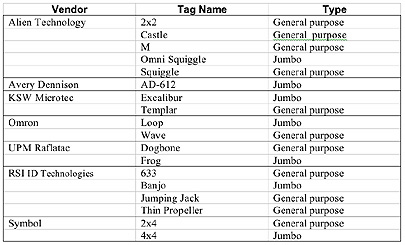Dulles, Va., RFID systems integrator and testing firm ODIN Technologies has published an RFID tag benchmark report. This report focuses on the performance of passive EPC Gen 2 UHF tags in a global supply-chain scenario, in which companies must be able to read tags in various parts of the UHF spectrum.
Tag makers are beginning to focus on designing RFID inlays that perform well at all three segments (low, middle and high) of the UHF range (860 to 960 MHz), rather than optimizing their performance to one part of the spectrum. They have found that as RFID systems scale from limited or site-specific tests to more global deployments, users need tags able to perform equally well in all three major sets of frequency ranges: 866 to 869 MHz (used in Europe), 902 to 928 MHz (the United States’ sanctioned range) and 951 to 954 MHz (the range specified in Japan).

Bret Kinsella, ODIN’s chief operating officer, says the company decided to conduct the benchmarking tests in response to requests from clients for information regarding which tags would perform best in global supply-chain deployments. “The tag makers are marketing [certain tags] as globally operable, but our clients wanted to know for sure that they would function as advertised,” he says.
For its benchmark test, ODIN put a total of 18 different passive EPC Gen 2 UHF tag inlays through a battery of tests designed to evaluate their performance. These inlays were manufactured by Alien Technology, Avery Dennison, KSW Microtec, Omron, UPM Raflatac, RSI ID Technologies and Symbol.
The inlays were divided into two categories: jumbo (having a footprint greater than 5.5 square inches) and general purpose (smaller than 5.5 square inches). They were tested for their ability to exploit an interrogator’s RF signal consistently and efficiently, for their read distance, for their sensitivity to orientation with respect to the reader, and for the impact of RF transmissions emitted by multiple RFID interrogators operating nearby. Each tag model underwent these tests in all three frequency ranges and mounted on three different objects: an empty corrugated cardboard case, one filled with metallic goods and another holding containers of water.
Compared with the general-purpose tags, jumbo tags have a greater surface area on which RF waves can propagate. As such, they tend to perform better than the former. The size of jumbo tags, however, makes them unusable for applications in which products require a tag with a small footprint. Additionally, jumbo tags tend to cost two to four times more than general-purpose tags.
Surprisingly, however, a number of general-purpose tags outperformed the jumbo tags in several tests, says Kinsella, and in multiple frequency ranges. For example, when attached to a case carrying containers of water, the Raflatac Dogbone general-purpose tag was nearly 100 percent readable in all three frequency ranges. The RSI 633 tag also performed well in this test.
Kinsella considers the stronger performance of some general-purpose tags in multiple test scenarios to be a “tremendous compliment to the companies that are working so hard to perfect these tags.” That they are cheaper and more versatile, he adds, is a boon to end users.
Kinsella also notes that overall, tags produced by Raflatac and KSW performed quite well. “This is the first time we included tags from KSW in a benchmark test, and though we have tested Raflatac tags before, they were not top performers [in those previous tests],” he says.
“There are some tags that, based on the results, we feel work well across the [UHF spectrum],” says Kinsella. Still, he points out, the purpose of the tests was to show how well Gen 2 tags will work in the various test scenarios and in the three frequency ranges, so companies can use the report to narrow in on the tags most appropriate to their global deployment. For example, if a firm is tagging cases of products with metallic content only, then the performance of a certain tag when applied to cases containing water-filled goods might not be very important.
Those interested can purchase the report from ODIN’s online store. Single-user licenses are available for $750, while enterprise licenses cost $1,500.

